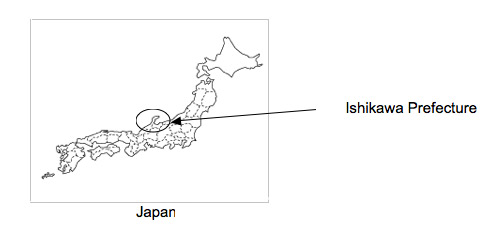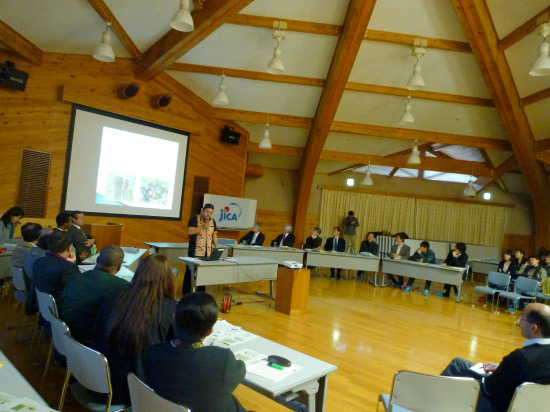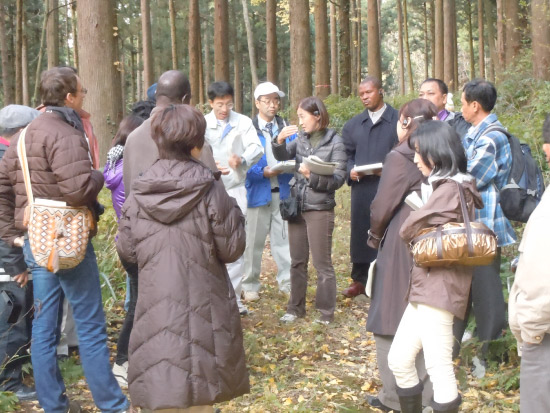(3) Partner Organizations
Ministry of the Environment, Japan, UNU-IAS Operating Unit Ishikawa/Kanazawa (UNU-IAS OUIK), Kanazawa University and Ishikawa Prefecture
(4) Period of program
November 2010 to December 2010
(5) Target Country
14 participants from 13 countries
(Indonesia, Malaysia, Viet Nam, Cambodia, India, Nepal, Costa Rica, Panama, Ethiopia, Malawi, Mali, Burkina Faso, Kyrgyzstan, Colombia)
(6) Overall Goal
The concept and case examples for the reconciliation between biodiversity conservation and sustainable use of natural resources would be shared among the people concerned in each participant’s country, and rural development plan harmonizing nature conservation and livelihood promotion would be implemented accordingly.
(7) Objective and Outcome
Learning from case examples of biodiversity conservation and sustainable use of natural resources with broad participation of stakeholders in Satoyama in Japan, training participants would understand the concept of SATOYAMA Initiative, related policy and case study of sustainable use of natural resources deep-rooted indigenous traditional culture in Japan.
Participants made action plan which described what participants would do for the rural development in their own countries from the viewpoint of the reconciliation between nature conservation and livelihood promotion based on the knowledge and experience gained from the Course.
(8) Contents
|
Expected Module Outputs
|
Program
|
Method
|
- Basic understanding of Satoyama, SATOYAMA Initiative and related policy
|
- SATOYAMA Initiative
- National Biodiversity Strategy
- Ishikawa Prefectural Biodiversity Strategy
- Policy of Satoyama and Satoumi conservation use in Ishikawa Pref.
|
Lecture |
|
(2) Understanding of concept and information sharing related conservation and use of biodiversity in Satoyama
|
- Sub-global Assessment of Satoyama and Satoumi
- Natural resources management in Satoyama and Satoumi
- Satoyama nature school
- Satoyama Satoumi project of Kanazawa university
- Nanao Bay Satoumi Revitalization Project
|
Lecture/
Inspection |
|
(3) Understanding of rural development through the sustainable use of natural resources
|
- Natural resource management in Satoyama and Satoumi
- Rural development project in Harmony with nature
- Satoyama Meister
- Model landscape of Kanakura, Wajima City
- Town promotion by cycle of local resources in Ikeda
|
Lecture/
Inspection |
|
(4) Mastery of the method of use of natural resources in business
|
- Business development based on resources in Satoyama
- Agro-forestry/Ecotourism
|
Lecture/
Case study |
|
(5) Understanding of conservation and sustainable use of natural resources deep-rooted indigenous traditional culture
|
- Wise use in Katano-Kamo-Ike (traditional hunting of duck)
- Conservation and use of traditional culture in Shiramine Shirayama city
|
Case study/
Inspection |
|
(6) Understanding concept of policy related to the tax burden for ecosystem services from satoyama in urban area
|
- Development of forestry activities by use of forest environment tax
- Forestry activity of the upper area of Tedori river
|
Lecture/
Inspection |
|
(7) Presentation at the symposium,
sharing of knowledge and experience in Japan and other countries, presentation of action plan *)
|
- Presentation of country report
- Attendance at the symposium
- Preparation and presentation of action plan
|
Practice |
*) Action Plan: The Plan which describes what participants do for the rural development in their own countries from the viewpoint of the reconciliation between nature conservation and livelihood promotion based on the knowledge and experience gained from the Course.
Action Plan should be worked out in the manner that it should be actually implemented back home as the training results. It is recommended that participants bring some relevant information in electronic form, such as figures, data, pictures and maps to prepare the action plan.




